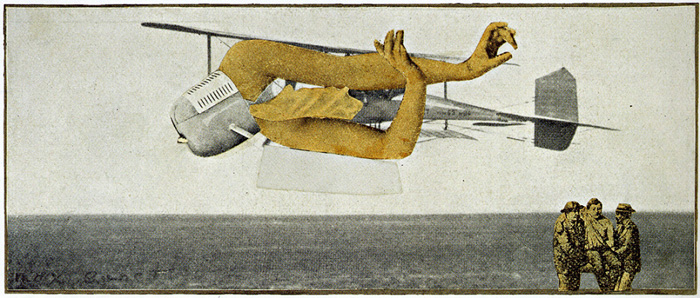Max Ernst has done several oil paintings. But he was best in producing collage pieces as illustrated by his work in murdering airplane. The name of the collage leaves lots of room for imagination. But it's an understandable bearing that Max was in the front-line during World War 1.
Ideally, murdering airplane is a collage of aeroplane with human hands. It looks like a human wearing silver headgear and a tie. On the right corner of the painting, there are three soldiers, but one is wounded, and so the two are carrying him — the surface or what seems like the ground is empty and lifeless. Bearing that Max engaged in WW1 together with the title of the collage, this piece has a deep meaning. First, machines are manufactured by a human. Secondly, man the machine deadly. During WW1 aerial combat was introduced. Planes and other devices were used to fight the war and the most advantaged group who owed the like of murdering airplane had a better front as compared to soldiers on the ground.
Ideally, the collage represents scale in regards to its size and the number of soldiers in the ground. As illustrated, the soldiers look venerable to the murdering machine. Well, the plane can't murder people by itself. It brings in the factor of human hands on the flight. It shows its man who controls machines to kill people. There is so much one could interpret from this art. For instance, the arms in the artwork look womanly and harmless. However, a woman is a mysterious person, and she could mean something and act differently.
Most of Max's work expresses fear and hope. Surprisingly, these are two virtue he experienced during his time while serving WW1. He also got his inspiration from travelling from one place to another because he got ideas while at it. Jean Arp also inspired Max. She introduced him to Dadaism and thus Tristan Tzara, who was also an artist. Another major inspiration is a metaphysical painting from which Max got the ideal of establishing surrealism. The surrealism movement inspired not only painting artist but also philosophers, poet, music writers and literature lovers. Ernst's son and grandson both took his footsteps of painting. Although the two concentrated on expression painting, they were inspired by Max's work. Ernst has also inspired other artists such as Marcel Duchamp and Marc Chagall who flew from war zone to New York alongside him.




